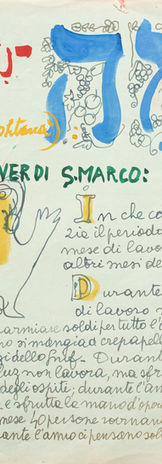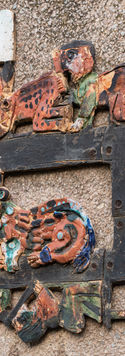Tel Broshim is the name of a grand farmhouse in Tuscany that after World War II was used for “Hachshara”- the preparation of young Jews for their future lives in the land of Israel. In this seminary participants learned about Zionism, and about life in the Kibbutz. They also practiced daily life in the kibbutz, learned Hebrew and kept an active farm. Lele’s sister, Gabriella, joined this seminary before she made Aliyah. Lele came to visit her sometimes, and on one occasion made a special tribute to the group- the Tel Broshim Haggadah. This spoof of the Haggadah tells of the group’s daily life in the seminary and introduces us to some of the group’s members. This booklet is full of Lele’s characteristic humor and storytelling abilities and yet, so different in its style and design and resembles the letters he used to send to his sister when they were younger. The people appearing in the Haggadah went on to make Aliyah and resided in kibbutz Ruhama, in the southern district of Israel, where some of them, and their families, still live today.
Title page of the "Tel Broshim Haggadah".

Tel Broshim was the name of a factory in Tuscany (called "Hakhsharah") which, after the Second World War, had the function of preparing and teaching Jews who wanted to live in Israel and live in kibbutz. In hakhsharah imparavano ebraico e sionismo, sperimentavano la vita collettiva as he lived in kibbutz and also employed in agriculture. La sorella di Lele, Gabriella, partecipò all 'hakhsharah per prepararsi ad andare a vivere in Israele, insieme ad altri amici e conoscenti. Lele talvolta l'andava a trovare; in one of those times created the "Haggadah of Tel Broshim", which describes the events of the group in hakhsharah. The owner shows the street that conducts this house di campagna-un viale che sale in collina, fiancheggiato da due file di cipressi alti e dritti. Even this haggadah, che if you report on the daily newspaper in hakhsharah and on the future in kibbutz, you will see a visual and illustrative faculty of Lele, che the design is not just a smoke I have a lot of children, but I also have specific specifications characters che la popolavano.
I membri del gruppo che compaiono nell'haggadah andarono in Israele insieme, si stabilirono nel kibbutz Ruhama e lì vivono fino ad oggi.


Comics depicting the daily life at the seminary.




Years later, Lele made two monumental works especially for the kibbutz. The two ceramic collections decorate the communal dining hall and depict the twelve tribes of Israel and the Exodus. Several aspects of these works are interesting; for once, the choice of subjects. Both pieces refer to the crucial time during which the Israelites became a nation. The twelve tribes may represent the idea that the people of Israel are made of different groups but they are strong and united together. Zionism and life at the kibbutz are, in this context, the way to reunite all the tribes scattered around the world- Kibbutz Galuyot. Another interesting thing is Lele’s choice of style and his space design, especially in the work depicting the Exodus. This works somewhat resembles the Lachish reliefs discovered in the mid-19th century. The reliefs depict the conquest of Judea by the Assyrians.
Anni dopo Lele feces donated to the kibbutz of two ceramic panels, as decoration of the outer wall of the refectory. A panel represents the symbols of the Tribes, the other is the one from Egypt. The selection of soggetti is interesting, and it can be interpreted in various ways: the kibbutz, as the singular record of groups in groups, so that the tribune if reunited to form a populace - it will be repeated the logo in which they reunite contemporary better part of kibbutz members, with its symbolic value.
Exalted by the Egyptians, as a colleague in the transformation of the Israelites into the Hebrew people, as a symbol of the second arrival in the Promised Land, after the Shoah.
The use of biblical ideas for a kibbutz to educate my fellow Zionists in the long run, for which all individuals who are stable in Israel are supported by this vision.
Interesting is also the scale of the composition in this space, which is recorded in some way the bassorilio of the Lakhish ascetic, in which it is narrated vice versa the destruction and conquest of the paese of the part of Sennacherib, re of Assyria. Il bassorilievo venne scoperto nel diciannovesimo secolo; the original found in the British Museum, and a copy can be found at the Museum of Israel in Jerusalem.

The twelve tribes of Israel, decorating the entrance to the communal dining hall in Kibutz Ruhama.

Exodus, Ceramic work decorating the exterior wall of the communal dining room at Ruhama.


%20(6).png)





































